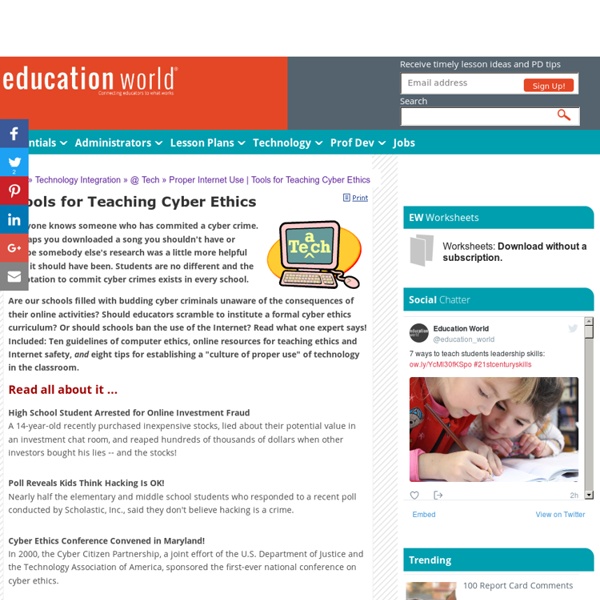Teaching Ethical Behavior in the Global World of Information and the New AASL Standards, School Library Media Activities Monthly, 2008-Dec
The American Association of School Librarians "Standards for the 21st Century Learner" (2007) expresses nine fundamental common beliefs. One of these beliefs is that "ethical behavior in the use of information must be taught" (AASL 2007, 1). It is important for library media specialists to understand that teaching ethical behavior is much more than teaching students about plagiarism. Libraries Unlimited.
Cyber Ethics
Educational articles are an excellent resource for parents who are interested in learning about the best parenting practices from experts in the field. With insights from top education specialists, these parenting articles provide advice and information for both typical and unusual parenting circumstances. A large range of topics are covered in these educational articles, from back-talking toddlers to college-bound teenagers. There are also articles about best practices to use with kids and teens with specific mental and physical needs. Popular Articles See All Articles Email
CONTENTS
6.The main idea of the following selection is that a.not only did the students like Hakeem’s song, they understood and appreciated the message it contained. b.the audience liked Hakeem’s song, even though they didn’t like Hakeem’s performance of it. c.Hakeem has shown that music can solve even the most serious problems. Slowly, one by one, students stood up, pressing their palms skyward in a gesture of enthusiastic approval. 7.The main idea of the following selection is that a.Darcy’s father never knew her very well. b.Darcy wishes her father cared less about her life. c.Darcy is worried things will never be the same between her and her father. Five years ago, Darcy would have told [her father] about Hakeem, but talking to him now about something personal seemed as awkward as sharing makeup secrets with a stranger. D.Conclusions 8.You can conclude from the following excerpt that a.Brisana and Hakeem are boyfriend and girlfriend. Brisana came closer. “Don’t give me that, Darcy.
referenceandinformationresources / Plagiarism Resources
Tutorials: Two brief videos from ABC News (one focuses on the videos available on YouTube that "teach" cheating): From Connect with Kids: High Tech Cheating A brief video and article (August 18th, 2010) Free Online Plagiarism Detection Tools: Bowman, V. (2004). NY: Neal-Schuman. Callahan, D. (2004). Orlando: Harcourt. Harris, R. (2004). Lathrop, A., & Foss, K. (2000). Englewood, CO: Libraries Unlimited. from cheating and plagiarism to honesty and integrity: Strategies for change. Libraries Unlimited. McKenzie, J. (1998). age. McKenzie, J. (2002). Minkel, W. (2002). Johnson, D. (2004) Plagiarism proofing assignments. Johnson is also the author of Learning Right from Wrong in the Digital Age: An Ethics Guide for Parents, Teachers, Librarians and Others who Care About Computer-Using Young People. Noodle Tools. (2006). template for a plagiarism policy and ways to teach notetaking. Pope, D.C. (2001). miseducated students. Big Nerds
Digital Literacy Standard Curriculum Version 3
Updated: July 1, 2011 The Digital Literacy Standard Curriculum Version 3 consists of five courses: Computer Basics The Internet and the World Wide Web Productivity Programs Computer Security and Privacy Digital Lifestyles Each course has an e-learning module and an assessment. Digital Literacy Version 3 teaches generic ICT skills and concepts, and features screen shots and simulations from Windows 7 and Microsoft Office 2010 to illustrate and provide hands-on examples for students. Go to Basic curriculum page Go to the Standard original version curriculum page Go to the Standard original version curriculum page for version 2 Go to Advanced curriculum page Get help choosing a curriculum version Get help choosing a course Get more information on assessments and the Certificate Test Take the Digital Literacy Certificate Test * A 56K connection or faster connection is recommended to access the offline options. Course Topics
A dozen ways to teach ethical and safe technology use
From the draft of my Survival Skills book: A dozen ways to teach and promote ethical and safe technology use Responsible teachers recognize that schools must give students the understandings and skills they need to stay safe not just in school, but outside of school where most Internet use by young people occurs. Over-filtered school networks set up a false sense of security; the real world of the Internet is quite different from the Internet at school. Teachers who address safe and ethical Internet use proactively: 1. 2. 3. 4. 5. 6. 7. 8. 9. 10. 11. 12. Will doing those things guarantee that a student will never get in trouble or danger online? Ethical instruction needs to be on going. * Johnson’s 3 P’s of Technology Ethics: Image source:



